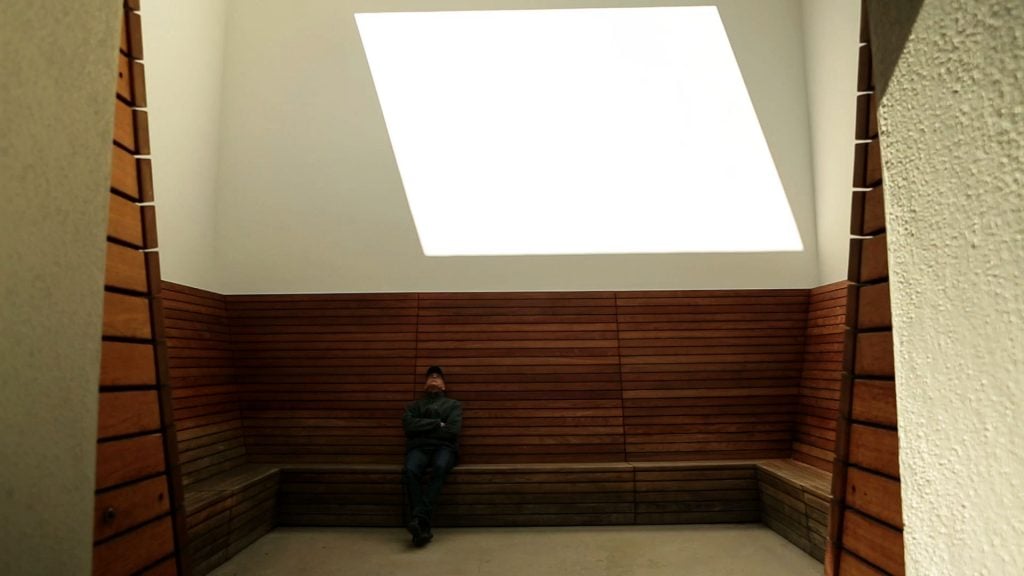‘I Want to Bring the Sky Down’: Watch Artist James Turrell Craft Extraordinary Works With the Radiant Power of Light
As part of a collaboration with Art21, hear news-making artists describe their inspirations in their own words.
As we settle into winter, the waning daylight hours are becoming more and more precious. Pioneering light and space artist James Turrell has spent his entire career trying to help viewers understand and appreciate that fleeting light as something valuable, on par with gold or silver.
In an exclusive interview with Art21 filmed back in 2013, Turrell reflects on his journey to make art experiences through harnessing the power of light.
“It’s not something that you form in the hands, like wax or clay,” he says. “You don’t carve it away like with wood or stone. You don’t assemble it like welding.”

Production still from the Art21 “Extended Play” film, “James Turrell: ‘Second Meeting.'” © Art21, Inc. 2013.
After bouts of experimentation, Turrell landed on the idea of the skyspace, where a square patch of a ceiling in an enclosed space opens up into the heavens, allows visitors to peer through void and into the sky.
In the video, he sits and contemplates the sky in his work Second Meeting, which was originally installed at the Museum of Contemporary Art in Los Angeles in 1986.
“I want to bring the space of the sky down to the top of the space you’re in, so that you really feel at the bottom of the ocean of air,” he tells Art21. “We do create the reality in which we live.”
Watch the video, which originally appeared as part of Art21’s series Extended Play, below. The brand new 10th season of the show is available now at Art21.org.
This is an installment of “Art on Video,” a collaboration between Artnet News and Art21 that brings you clips of newsmaking artists. A new series of the nonprofit Art21’s flagship series Art in the Twenty-First Century is available now on PBS. Catch all episodes of other series like New York Close Up and Extended Play and learn about the organization’s educational programs at Art21.org.
JAMES TURRELL
Multimedia Guide
Catalogue
Programs
Installation Photos
KANDINSKY IN PARIS, 1934–1944
NEW HARMONY: ABSTRACTION BETWEEN THE WARS, 1919–1939
A LONG-AWAITED TRIBUTE: FRANK LLOYD WRIGHT'S USONIAN HOUSE AND PAVILION
THANNHAUSER COLLECTION
Posted: 14 Jul 2013 07:41 AM PDT
'Tis the season for James Turrell, with three major exhibitions this summer (at the Guggenheim, LACMA, and Museum of Fine Arts, Houston). Recently I wrote about the catalog to the LACMA show for Designers & Books, so, like everybody, I'm on a Turrell kick. Here are a few videos to satiate anybody's interest in the artist of light.
James Turrell on June 27 episode of Charlie Rose (skip ahead to ~28 minute mark):
"James Turrell's Roden Crater" from LACMA (click image to watch video at Vimeo):
James Turrell in conversation with LACMA Director Michael Govanat the Guggenheim on June 21:
James Turrell | American Artist – Roden Crater – Skyspace – Light ...
jamesturrell.com/
James Turrell artist site documenting 140 artworks and installations around the world including Roden Crater.
http://archidose.blogspot.tw/2013/07/book-review-4-books-on-4-exhibitions.html

James Turrell: A Retrospective
By Michael Govan, Chrisine Y. Kim
Prestel, 2013
Hardcover, 304 pages
Fans of James Turrell are being treated this year with three major exhibition on the artist: “James Turrell: A Retrospective” at the Los Angeles County Museum of Art (LACMA), “James Turrell” at the Guggenheim Museum in New York, and “James Turrell: The Light Inside” at the Museum of Fine Arts, Houston. To accompany the show at LACMA, curator Michael Govan has put together an impressive catalog with Christine Y. Kim that charts the artist's five-decade-long career and beautifully documents his “skyspaces” and other architectural constructions, most notably the ongoing Roden Crater project in Arizona.
Turrell's career to date is covered in ten chapters interspersed by four essays—two introductory essays by Govan and Kim, the others by Alison de Lima Greene and E.C. Krupp. Kim's essay is required reading, since it not only gives a biography of Turrell's life but also features his words through interviews; after direct experience, Turrell's work is best understood through his own concise but complex descriptions. The ten chapters focus on particular themes and types of works (painting in space, blind light, sky light, etc.) that end up tracing a roughly chronological path. This means that his ongoing work at Roden Crater in Arizona is found near the end of the book; logical, since it is the culmination of his years of working with light and perception.
The longest chapter is the one devoted to what Turrell calls "Skyspaces," typically one-room constructions with a square or circular oculus open to the sky. Skyspaces can be found all over the world, and they are the pieces that architects most appreciate because they are spatial but also transcendent. In addition to the many photographs in the book, architects should appreciate the occasional construction drawings documenting the Skyspaces and other installations. Like a magician’s secrets, they reveal what is hidden and what enables the spaces to be perceived in certain ways, while also illustrating how they are physical constructions that rely on particularly complex details.
Not surprisingly, Turrell’s installations and Skyspaces are best experienced firsthand (this points to the obvious recommendation to visit at least one of the museums holding a Turrell exhibition). They can be discussed and documented, as they are in this book, but that is hardly a substitute for the tangible effects that happen when sensing one of his works, ideally for long durations. That said, kudos should go to Florian Holzherr, whose large color photos grace most pages of the book and help to make it such a remarkable document of an artist worth all the attention.

沒有留言:
張貼留言